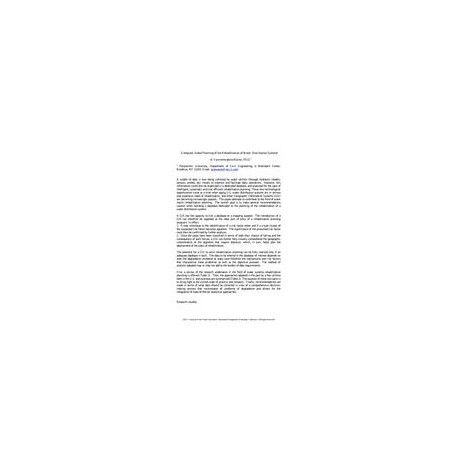Cart
0
Product
Products
(empty)
No products
To be determined
Shipping
$0.00
Total
Product successfully added to your shopping cart
Quantity
Total
There are 0 items in your cart.
There is 1 item in your cart.
Total products
Total shipping
To be determined
Total
New
Reduced price!
 View larger
View larger
 View larger
View larger
AWWA IMTECH59617
M00053408
New product
AWWA IMTECH59617 Computer Aided Planning of the Rehabilitation of Water Distribution Systems
Conference Proceeding by American Water Works Association, 04/18/2004
Vanrenterghem-Raven, A.
Full Description
A wealth of data is now being collected by water utilities (through hydraulic models, sensors, probes, etc.) mostly to improve and facilitate daily operations. However, this information could also be organized in a dedicated database, and analyzed for the sake of intelligent, systematic and cost efficient rehabilitation planning. These new technological opportunities come at a time when aging U.S. water distribution systems are in serious and expensive need of rehabilitation, and when Geographic Information Systems (GIS) are becoming increasingly popular. This paper attempts to contribute to the field of water mains rehabilitation planning. The overall goal is to make general recommendations caution when building a database dedicated to the planning of the rehabilitation of a water distribution system. A GIS has the capacity to link a database to a mapping support. The introduction of a GIS can therefore be regarded as the ideal port of entry of a rehabilitation planning program. In effect: it may contribute to the identification of a risk factor when and if a visual cluster of the suspected risk factor becomes apparent; the significance of the presumed risk factor must then be confirmed by further analysis; and, once the pipes have been classified in terms of both their chance of failing and the consequence of such failure, a GIS can further help visually comprehend the geographic concentration of the segments that require attention; which, in turn, helps plan the deployment of the tasks of rehabilitation. The potential for a GIS to serve rehabilitation planning can be fully realized only if an adequate database is built. The data to be entered in the database of interest depends on both the degradation problems at stake (and therefore the mechanisms and risk factors that characterize these problems) as well as the objective pursued. The method of analysis adopted may or may not add to the burden of data requirements. The paper presents a review of the research undertaken in the field of water systems rehabilitation planning. Then, the approaches adopted in the past by a few utilities both in the U.S. and overseas are summarized. The purpose of these two parts is to highlight the current state of practice and research. Finally, recommendations are made in terms of what data should be collected in view of a comprehensive decision-making process that incorporates all problems of degradation and allows for the integration of state-of-the-art analytical approaches. Includes 37 references, tables, figure.In stock

